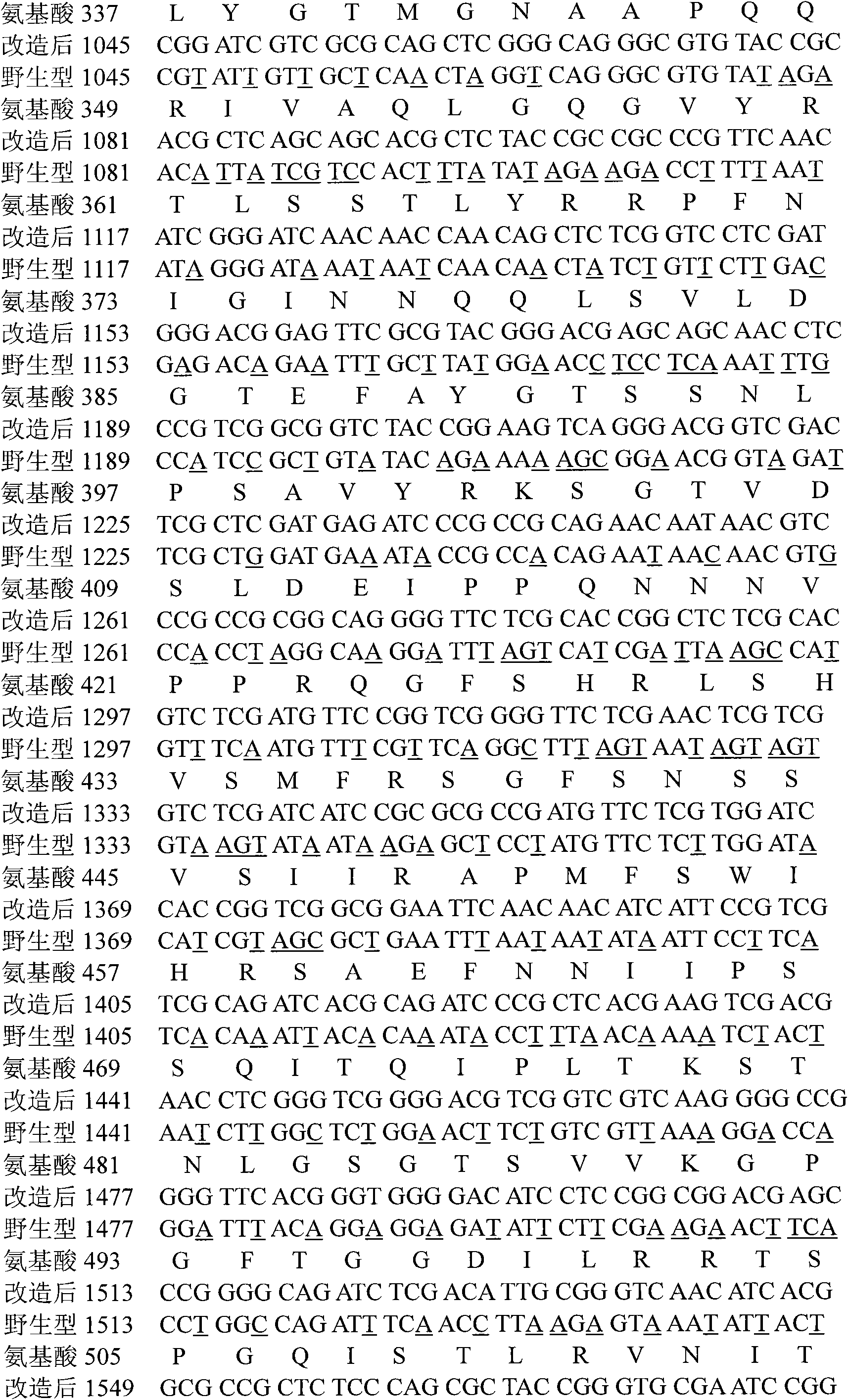Pesticidal protein encoding gene Cry1Ab-Ma and expression vector and application thereof
A cry1ab-ma, insect-resistant gene technology, applied in the fields of application, genetic engineering, plant genetic improvement, etc., can solve the problems of ecological imbalance, lack of insect-resistant varieties, environmental pollution, etc., to reduce the amount of use, enhance expression, reduce Effects of Environmental Pollution
- Summary
- Abstract
- Description
- Claims
- Application Information
AI Technical Summary
Problems solved by technology
Method used
Image
Examples
Embodiment 1
[0030] Synthesis of embodiment 1Cry1Ab-Ma gene
[0031] According to the original nucleotide sequence of the Bt gene Cry1Ab, a base sequence of 1623bp at the 3' end was removed, leaving only a partially deleted base sequence of 1845bp at the 5' end; In the case of changes, base substitutions are carried out with plant-favored codons, and a modified DNA sequence is initially obtained; AT-rich sequences (such as ATTTA, AATGAA, etc.) and common restrictions that exist in the DNA sequence that cause plant transcription instability are excluded SacI, and then correct and eliminate it by replacing the codon; and add a stop codon TAG at the 3' end; determine and chemically synthesize the transformed Bt gene, its nucleotide sequence is as shown in SEQ ID No .1 shown; according to the needs of cloning, add restriction endonuclease recognition site sequences at both ends of the sequence and construct it into the corresponding expression vector.
[0032] The original Bt gene Cry1Ab was co...
Embodiment 2
[0034] Example 2 Expression of Cry1Ab-Ma gene in prokaryotic system and detection of product toxicity
[0035] In order to detect the in vitro expression of the modified Cry1Ab-Ma gene and its toxicity to the corn borer, we constructed a Bt prokaryotic expression vector. According to the needs of cloning the Bt gene, the NdeI endonuclease recognition site sequence CATATG was added to the 5' end of the primer sequence, and the HindIII endonuclease recognition site sequence AAGCTT was added to the 3' end. Primer sequences were designed (upstream primer F1: 5"-CATATGGACAACAACCCGAACATC-3'; downstream primer R1: 5'-AAGCTTCTAGTACTCCGCCTCG-3').
[0036] Using the pUCAb-Ma plasmid as a template, using F1 and R1 as primers, the Cry1Ab-Ma gene was amplified, digested with restriction endonucleases NdeI and HindIII, and the gel recovery kit recovered and purified the Cry1Ab-Ma gene fragment. Digest pET28b+ with restriction endonucleases NdeI and HindIII, and recover and purify the 5.3kb...
Embodiment 3
[0048] Example 3 Expression of Cry1Ab-Ma gene in transgenic plants and detection of toxicity of expression products
[0049] The T vector plasmid pUCCry1Ab-Ma was digested with XbaI and SacI, and the Cry1Ab-Ma fragment was recovered with a gel extraction and purification kit. At the same time, the plant expression vector CPB was double-digested with XbaI and SacI, and the digested CPB fragment was recovered with a gel extraction and purification kit. The two fragments were ligated to construct the eukaryotic expression plasmid pCAMBIA1300-Cry1Ab-Ma-Bar (the promoter is CaMV35S, the marker gene is the herbicide resistance gene Bar of Streptomyces hygroscopicus). Restriction identification showed that the vector was constructed correctly.
[0050] Among them, CPB (pCAMBIA1300-35S-MCS-Bar, figure 2 ) plasmid is a plasmid constructed on the basis of pCAMBIA1300 plasmid, which contains a target gene insertion cassette (35S-multicloning restriction site-Tnos) and a herbicide resi...
PUM
 Login to View More
Login to View More Abstract
Description
Claims
Application Information
 Login to View More
Login to View More - Generate Ideas
- Intellectual Property
- Life Sciences
- Materials
- Tech Scout
- Unparalleled Data Quality
- Higher Quality Content
- 60% Fewer Hallucinations
Browse by: Latest US Patents, China's latest patents, Technical Efficacy Thesaurus, Application Domain, Technology Topic, Popular Technical Reports.
© 2025 PatSnap. All rights reserved.Legal|Privacy policy|Modern Slavery Act Transparency Statement|Sitemap|About US| Contact US: help@patsnap.com



